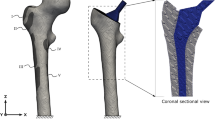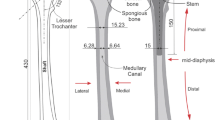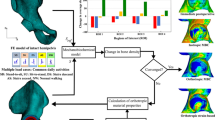Abstract
Bone tissue is a porous, heterogeneous and anisotropic material, which adapts its mechanical properties depending of the local stress level. This evolutive behaviour of the bone is normally known as bone remodelling. In this work, a bone-remodelling theory, based on the principles of continuum damage mechanics, is presented. The corresponding mathematical formulation has been implemented in a finite element code in order to predict the bone response after implantation of a prosthesis or fixation. Although the present model is not based on experimental verification, the model predicts important qualitative experimental results, being still necessary to test against experimental/clinical work. The main aim of this paper has been, therefore, the qualitative study of the long-term bone evolution, especially of the human femur when different types of implants are employed. A comparative analysis between two widely used hip prostheses (the Exeter and the SHP), has been performed. We have also studied the treatment of proximal femoral fractures by means of extramedullary and intramedullary implants.
Similar content being viewed by others
References
Lemaitre, J., ‘A continuous damage mechanics model for ductile fracture’, J. Eng. Mater. Technol. 107 (1985) 83-89.
Cordebois, J.P. and Sideroff, F., ‘Damage induced elastic anisotropy’, Mechanical Behavior of Anisotropic Solids, in, Proc. EUROMECH Colloquium 115, 1982, pp. 761-774.
Kachanov, L.M., ‘Time of the rupture process under creep conditions’, IVZ Akad. Nauk S.S.R. Otd Tech Nauk 8 (1958) 26-31.
Prendergast, P.J. and Taylor, D., ‘Prediction of bone adaptation using damage accumulation’, J. Biomech. 27(8) (1994) 1067-1076.
Huiskes, R., Weinans, H., Grootenboer, H.J., Dalstra, M., Fudala, B. and Sloof, T.J., ‘Adaptive bone-remodeling theory applied to prosthetic-design analysis’, J. Biomech. 20(11/12) (1987) 1135-1150.
Carter, D.R., Orr, T.E. and Pyhrie, D.P., ‘Relationships between loading history and femoral cancellous bone architecture’, J. Biomech. 22(3) (1989) 231-244.
Beaupré, G.S., Orr, T.E. and Carter, D.R., ‘An approach for time-dependent bone modeling and remodelingapplication: A preliminary remodeling simulation’, J. Orthopaedic Res. 8(5) (1990) 662-670.
Jacobs, C.R., Numerical Simulation of Bone Adaptation to Mechanical Loading, Dissertation for the Degree of Doctor of Philosophy, Stanford University, 1994.
Cowin, S.C., Sadegh, A.M. and Luo, G.M., ‘An evolutionary Wolff's law for trabecular architecture’, J. Biomech. Eng. 114 (1992) 129-136.
Doblaré, M. and García, J.M., ‘Anisotropic bone remodelling model based on a continuum damage-repair Theory’, J. Biomech. 35(1) (2002) 1-17.
Van Rietbergen, B., Odgaard, A., Kabel, J. and Huiskes, R., ‘Direct mechanics assesment of elastic symmetries and properties of trabecular bone architecture’, J. Biomech. 29(12) (1996) 1653-1657.
Odgaard, A., Kaber, J., Van Rietbergen, B., Dalstra, M. and Huiskes, R., ‘Fabric and elastic principal directions of cancellous bone are closely related’, J. Biomech. 30(5) (1997) 487-495.
Martin, R.B., ‘Porosity and specific surface of bone’, CRC Critical Reviews Biomed. Engineer. (1984) 179-222.
Simo, J.C. and Ju, J.W., ‘Strain-and stress-based continuum damage models. I. Formulation’, Int. J. Solids Struct. 23 (1987) 821-840.
Hibbit, Karlsson and Sorensen, Inc., ‘ABAQUS’, User's Manual, Version 6.1, 2000.
Doblaré, M. and García, J.M., ‘Application of an anisotropic bone remodelling model based on a damagerepair theory to the analysis of the proximal femur before and after total hip replacement’, J. Biomech. 34(9) (2001) 1157-1170.
García, J.M., Martínez, M.A. and Doblaré, M., ‘An anisotropic internal-external bone adaptation model based on a combination of CAO and continuum damage mechanics technologies’, Computer Meth. Biomech. Biomed. Eng. 4(4) (2001) 355-378.
Ling, R.S.M., The history and development of the exeter hip, 1997 (www.howmedica.com/exeter/index.html)
Huiskes, R. and Boeklagen, R., ‘Mathematical shape optimisation of hip prosthesis design’, J. Biomech. 22(8-9) (1989) 793-804.
Huiskes, R., Verdonschot, N. and Nivbrant, B., ‘Migration, stem shape and surface finish in cemented total hip arthroplasty’, Clinical Orthopaedics 355 (1998) 103-112.
Müller, M.E., Allgöwer, M., Schneider, R. and Willenegger, H., Manual de Osteosíntesis, Springer-Verlag, Ibérica, 1993.
Pedersen, D.R., Brand, R.A. and Davy, D.T., ‘Pelvic muscle and acetabular contact forces during gait’, J. Biomech. 30(9) (1997) 959-965.
Kempf, I., Grosse, A., Taglang, G. and Favreul, E., ‘Le clou Gamma dans le traitement à foyer fermé desfractures trochantériennes. Résultats et indications à propos d'une série de 121 cas’, Rev. Chir. Orthop. 79 (1993) 29-40.
Regazzoni, P., Rüedi, Th., Winquist, R. and Allgöwer, M., The Dynamic Hip Screw Implant System, Springer-Verlag, Madrid, 1985.
Wang, C.J., Yettram, A.L., Yao, M.S. and Procter, P., ‘Finite element analysis of a Gamma nail within a fractured femur’, Med. Eng. Phys. 20(9) (1998) 677-683.
Sim, E., Freimuller, W. and Reiter, T.J., ‘Finite element analysis of the stress distributions in the proximal end of the femur after stabilization of a pertrochanteric model fracture: a comparison of two implants’, Injury 26(7) (1995) 445-449.
Prendergast, P.J., ‘Finite element models in tissue mechanics and orthopaedic implant design’, Clinical Biomech. 12(6) (1997) 343-366.
Kuiper, J.H. and Huiskes, R., ‘The predictive value of stress shielding for quantification of adaptive bone resorption around hip replacements’, J. Biomech. Eng. 119 (1997) 228-231.
Kerner, J., Huiskes, R., van Lenthe, G.H., Weinans, H., van Rietbergen, B., Engh, C.A. and Amis, A.A., ‘Correlation between pre-operative periprosthetic bone density and post-operative bone loss in THA can be explained by strain-adaptive remodelling’, J. Biomech. 32 (1999) 695-703.
McNamara, B.P., Prendergast, P.J. and Taylor, D., ‘Prediction of bone adaptation in the ulnar-osteotomized heep's forelimb using an anatomical finite element model’, J. Biomed. Eng. 14(3) (1992) 209-216.
Author information
Authors and Affiliations
Rights and permissions
About this article
Cite this article
Doblaré, M., García, J. & Cegoñino, J. Development of an Internal Bone Remodelling Theory and Applications to Some Problems in Orthopaedic Biomechanics* . Meccanica 37, 365–374 (2002). https://doi.org/10.1023/A:1020835720405
Issue Date:
DOI: https://doi.org/10.1023/A:1020835720405




